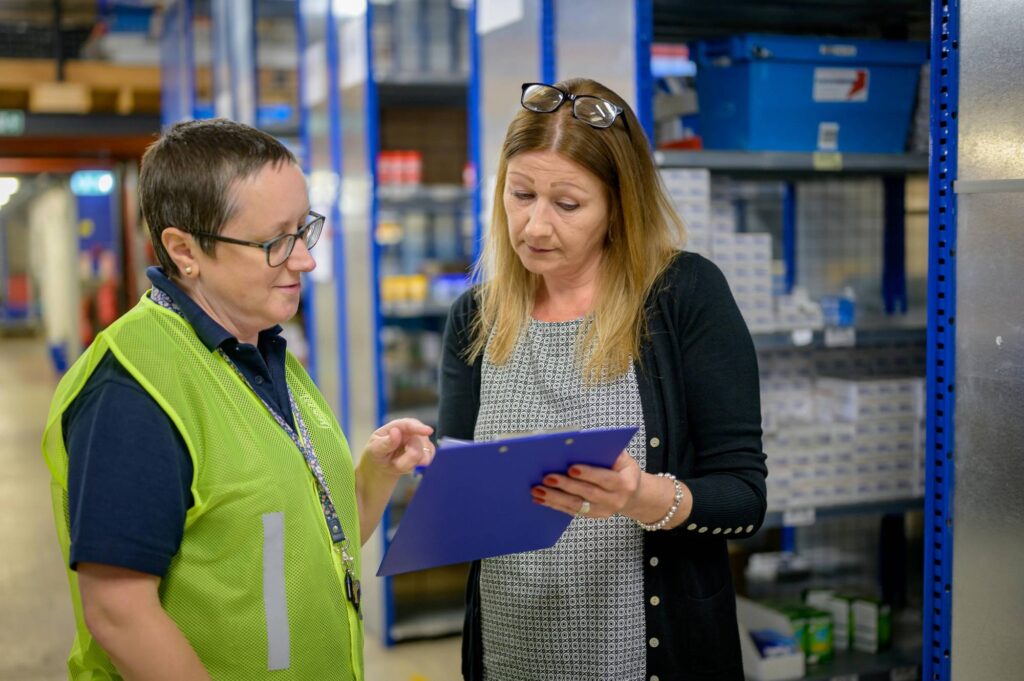Success demands more than great products and pricing—it requires efficient supply chain and inventory management. This is where third party logistics inventory management becomes a strategic game-changer.
By leveraging third party inventory management, retail businesses can streamline their operations, minimize costs, and improve overall performance. Here’s how 3PL inventory management enhances inventory accuracy, optimizes fulfillment, and positions retailers for scalable, customer-centric success.
Table of Contents
Key Takeaways✔ 3PL inventory management minimizes errors by replacing manual entry through automated systems. ✔ Retailers gain real-time visibility across all channels using integrated tracking tools. ✔ Automated scanning and tracking streamline inventory reconciliation and reduce discrepancies. ✔ Enhanced SKU-level transparency allows retailers to identify fast-moving and underperforming products. ✔ Accurate data from 3PL systems enables better forecasting and more strategic inventory planning. |
What is Third Party Logistics Inventory Management?
Third party logistics inventory management refers to outsourcing inventory-related tasks to specialized providers known as 3PLs (Third Party Logistics companies). These providers handle functions such as receiving, warehousing, order picking, packaging, shipping, and returns. Their expertise allows businesses to offload operational complexities and focus on core competencies like product development and customer experience.
A reliable 3PL inventory management partner integrates advanced technologies such as Warehouse Management Systems (WMS), RFID tagging, and inventory scanning tools. These tools ensure real-time visibility and control over stock levels, helping businesses avoid costly errors like overstocking or understocking.
Through third party logistics inventory management, retailers access a network of distribution centers, streamlined workflows, and professional-grade fulfillment practices — all without the infrastructure investment traditionally required.
How 3PL Enhances Retail Inventory Accuracy
Accurate inventory is critical to efficient retail operations. Mistakes lead to missed sales, unnecessary storage costs, and dissatisfied customers. 3PL inventory systems eliminate manual inefficiencies, improving accuracy and data consistency.
By using real-time tracking and barcode scanning, 3PLs provide a consolidated, up-to-date view of inventory across all channels. This increases stock accuracy by up to 35%, reducing discrepancies and boosting reconciliation efficiency.
Additionally, third party logistics inventory management offers greater SKU-level transparency. Retailers can identify fast-moving items, dormant stock, and replenishment cycles with precision, empowering better forecasting and strategic planning.
1. Streamlined Order Fulfillment and Returns
A major strength of 3PL inventory management is its ability to optimize the entire fulfillment process, ensuring orders move from warehouse to customer without unnecessary delays or errors.
Retailers today manage orders from multiple channels — e-commerce sites, physical stores, mobile apps, and marketplaces like Amazon or Walmart. Without specialized systems and staff, this complexity can lead to bottlenecks. Third party logistics inventory management solves this by introducing automated, coordinated workflows that keep operations on track.
Key advantages include:
- Multi-Channel Fulfillment Support: 3PL providers manage orders from different sales platforms and synchronize them into one centralized system, reducing confusion and delays.
- Efficient Order Picking and Packing: Automated picking systems and optimized warehouse layouts speed up the process and reduce human error, ensuring the right items reach customers every time.
- Fast and Cost-Effective Shipping: Many 3PLs offer access to a broad network of carriers with discounted rates. Orders are shipped from the nearest fulfillment center to minimize delivery time and cost.
- Real-Time Order Tracking and Notifications: Integrated tracking allows customers and retailers to monitor orders from placement to delivery, improving transparency and satisfaction.
- End-to-End Returns Management (Reverse Logistics): 3PL inventory management includes a dedicated process for returns:
- Pre-printed return labels
- Automated return authorizations
- Real-time restocking and inventory updates
- Customer communication support
- Pre-printed return labels
- Consistency Across Fulfillment Touchpoints: Even when handling large order volumes or return surges, 3PL providers maintain a consistent level of service quality, protecting the retailer’s brand reputation.
2. Seasonal and Promotional Readiness
Retail businesses experience sharp demand fluctuations during holidays, product launches, and flash sales. Unprepared teams often struggle with inventory shortages, shipping delays, and fulfillment errors. This is where third party logistics inventory management becomes a valuable strategic asset.
3PLs help retailers stay agile and fully equipped for surges in demand without permanent infrastructure changes. By tapping into the power of third party inventory management, retailers can approach peak seasons and promotional periods with confidence, maximizing revenue without compromising on customer experience.
Key benefits include:
- Scalable Warehouse Capacity: Retailers don’t need to invest in extra warehouse space year-round. 3PLs adjust storage allocation based on seasonal needs.
- On-Demand Labor Flexibility: Instead of hiring temporary in-house staff, 3PLs provide trained labor to handle high order volumes, ensuring faster turnaround times.
- Inventory Staging: Products can be pre-positioned in key distribution centers closer to customers in high-demand regions, reducing delivery lead times.
- Kitting and Pre-Assembly Services: For promotional bundles or limited-time product sets, 3PLs offer kitting services that streamline the packing of multiple items into a single unit.
- Event-Specific Logistics Planning: 3PL inventory management includes planning for known sales events like Black Friday and Cyber Monday, back-to-school sales, and product drops or influencer campaigns.
- Risk Mitigation During Demand Surges: With flexible fulfillment options and optimized workflows, retailers can avoid late deliveries, order processing backlogs, and negative customer reviews due to seasonal chaos.

3. Improved Operational Efficiency and Cost Control
Beyond improving inventory accuracy, third party inventory management serves as a strategic tool for reducing operational friction and controlling expenses. With a single provider managing multiple logistics functions, retailers can unlock efficiencies that would be difficult to achieve independently. Together, these factors support leaner operations and healthier profit margins — critical advantages in an increasingly competitive retail environment.
Key efficiency and cost-saving benefits include:
- Consolidated Logistics Operations: 3PL providers manage warehousing, fulfillment, shipping, and returns within a unified system. This eliminates the need for multiple vendors and streamlines coordination.
- Lower Overhead Costs: Businesses avoid the financial burden of owning or leasing large warehouse spaces, managing maintenance, or staffing a full logistics team.
- Shared Infrastructure Savings: Third party logistics inventory management allows businesses to share warehouse space, labor, and equipment with other clients — reducing costs through economies of scale.
- Optimized Transportation Management: Many 3PLs negotiate bulk shipping discounts with carriers, passing on the savings to their clients. Route optimization also reduces fuel costs and delivery delays.
- Demand-Based Resource Allocation: Retailers only pay for what they use — whether it’s storage space, labor hours, or transportation services. This flexible pricing model helps avoid wasteful spending.
- Advanced Data Analytics and Forecasting Tools: 3PL inventory management platforms offer performance dashboards and predictive insights that identify inefficiencies, improve demand planning, and optimize reorder points and safety stock levels. A McKinsey study found that companies leveraging big data analytics in their supply chains achieved a 15–20% decrease in inventory levels and cut supply chain costs by 5–10%.
- Reduced Inventory Holding Costs: By improving turnover rates and avoiding overstocking, retailers reduce capital tied up in excess inventory.
4. Enhanced Customer Satisfaction Through 3PL
Customer expectations have never been higher. They want speed, accuracy, and transparency throughout the buying process. Third party logistics inventory management plays a central role in meeting — and exceeding — those expectations. By providing the logistics backbone for top-tier service, 3PL inventory management becomes a critical partner in building lasting customer relationships.
Key customer experience benefits include:
- Fast and Reliable Delivery Options: 3PLs operate from strategically located distribution centers, enabling two-day or even same-day delivery in select regions and faster fulfillment for priority orders.
- Real-Time Order Tracking: Integration with order management systems provides up-to-the-minute tracking updates, which builds customer trust and reduces “Where is my order?” inquiries.
- Accurate and Complete Deliveries: Automated picking and packing processes minimize shipping errors, ensuring customers receive the right products the first time.
- Seamless Return Experiences: Efficient reverse logistics enable easy returns with clear instructions, pre-labeled packaging, and fast refunds or replacements.
- Omnichannel Fulfillment Capabilities: 3PL inventory management supports hybrid fulfillment models, including: Buy Online, Pick Up In Store (BOPIS), ship-from-store, and dropshipping for expanded catalogs.
- Consistent Brand Experience: Whether customers are ordering online or in-store, 3PLs help maintain uniform service levels and packaging standards.
- Higher Retention and Brand Loyalty: With fewer delivery issues and smoother experiences, retailers see more repeat purchases and customer referrals.
5. Customization and Scalability for Growing Retailers
Retail operations are far from one-size-fits-all. That’s why third party inventory management is built with flexibility at its core — enabling businesses of all sizes and models to scale efficiently while maintaining control. By providing adaptable, scalable solutions, third party logistics inventory management empowers retailers to grow with confidence — adjusting quickly to market demands, new opportunities, and operational changes without overextending internal resources.
Key benefits include:
- Tailored Service Packages: Third party logistics providers assess each retailer’s structure and customize logistics solutions to match their unique sales channels, inventory types, and customer expectations.
- Flexible Warehouse Configurations: From high-turnover items to specialty products, 3PLs can adjust storage layouts and capacity to accommodate diverse inventory needs.
- Onboarding and Transition Support: Moving to a 3PL system is seamless thanks to guided onboarding, platform integration, and process alignment with existing operations.
- Scalable Labor and Technology: As order volumes grow, retailers don’t have to invest in new staff or infrastructure. 3PLs provide on-demand labor and automated tools to match scaling needs instantly.
- Multi-Location Fulfillment: Many 3PL providers operate multiple warehouses, enabling retailers to distribute inventory closer to customers and reduce delivery times.
- Support for Product Line Expansion: Whether launching new items or bundling products for promotions, 3PL systems can adapt packing instructions, storage needs, and fulfillment workflows without disruption.
- Business Model Flexibility: Retailers shifting to omnichannel models, launching subscriptions, or entering new markets can rely on their 3PL partner to adapt logistics strategies accordingly.
- Cost-Effective Scaling: Growth doesn’t require capital-intensive investments. 3PL inventory management allows businesses to expand while only paying for the services and space they use.
Choosing the Right 3PL Partner for Inventory Management
The effectiveness of third party logistics inventory management hinges on choosing the right partner. While many 3PL providers offer similar services on the surface, their capabilities, experience, and approach can vary widely. Selecting the wrong provider may lead to misaligned operations, inefficiencies, and missed growth opportunities.
Choosing a third party inventory management partner is not just a procurement decision — it’s a strategic investment in your supply chain. The right 3PL will act as an extension of your team, helping you grow, adapt, and deliver consistently outstanding service to your customers. To make an informed decision, retailers should evaluate potential 3PL partners based on the following criteria:
- Technology Integration: The provider should offer robust systems that integrate seamlessly with your e-commerce platform, order management system, and ERP. Real-time data syncing is essential for inventory visibility, order tracking, and accurate reporting.
- Industry Experience: A 3PL that understands your specific retail vertical — whether it’s fashion, electronics, health products, or subscription boxes — will be more equipped to handle your operational nuances and seasonal trends.
- Geographic Reach: Providers with a network of warehouses in strategic locations can store inventory closer to end customers. This reduces delivery times, lowers shipping costs, and improves overall fulfillment performance.
- Communication and Support: Transparent, responsive support is critical. The 3PL should offer dedicated account managers, clear escalation procedures, and real-time access to service metrics and order statuses.
- Customization Options: Look for flexibility in fulfillment models, packaging preferences, inventory reporting, and billing structures. The 3PL should adapt to your business model, not the other way around.
- Scalability and Growth Readiness: As your business grows, your logistics partner must keep up. Ensure they can handle volume spikes, geographic expansion, and added product lines without disruption.
- Security and Compliance: Warehouses and data systems should follow strict security protocols. If you’re handling sensitive goods, ensure the provider meets industry-specific regulatory standards.
- Client References and Case Studies: Ask for testimonials, references, or documented success stories. Past performance is a strong indicator of reliability and consistency.
- Service Level Agreements (SLAs): Review SLAs for fulfillment accuracy, delivery timelines, returns processing, and system uptime. These documents define accountability and set expectations for performance.
Frequently Asked Questions
What is 3PL inventory management?
3PL inventory management refers to the outsourcing of inventory storage, tracking, and fulfillment operations to a third-party logistics provider. These providers manage warehousing, picking, packing, shipping, and returns on behalf of retailers or manufacturers. This service helps businesses reduce operational burdens, improve accuracy, and scale efficiently without owning infrastructure.
What is logistics inventory management?
Logistics inventory management involves overseeing the flow of goods within a supply chain, from storage to distribution. It ensures that inventory levels are optimized to meet demand without overstocking or understocking. Effective logistics inventory management enhances order accuracy, reduces costs, and supports timely delivery to customers or retail locations.
What is the difference between a warehouse and a 3PL?
A warehouse is a physical facility used solely for storing goods, typically managed by the business that owns the inventory. In contrast, a 3PL (third-party logistics provider) offers a full suite of services, including warehousing, transportation, order fulfillment, and returns management. While a warehouse is a storage solution, a 3PL acts as an outsourced logistics partner that helps businesses manage end-to-end supply chain operations.
What are the four types of inventory management systems?
The four main types of inventory management systems are periodic, perpetual, barcode, and radio frequency identification (RFID). Periodic systems rely on scheduled counts, while perpetual systems update inventory in real-time with every transaction. Barcode and RFID systems use technology to automate tracking and improve inventory accuracy across the supply chain.
What are the 7 R's of logistics management?
The 7 R’s of logistics management are the Right product, Right quantity, Right condition, Right place, Right time, Right customer, and Right cost. These principles serve as the foundation for delivering high-quality logistics services. By ensuring each “R” is met, businesses can optimize supply chain efficiency and enhance customer satisfaction.
Partner with 3PL Logistics By Best for Smarter Inventory Management in NYC!
Ready to optimize your retail operations? 3PL Logistics By Best offers scalable, tech-driven logistics solutions tailored to New York City retailers. From real-time tracking to efficient fulfillment, we help businesses reduce costs, enhance accuracy, and grow with confidence.
Don’t let outdated logistics slow you down. Choose 3PL Logistics By Best — your trusted NYC partner — and take control of your inventory today.

